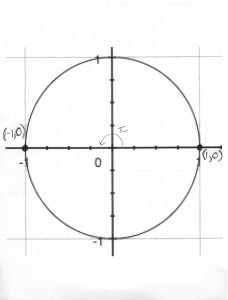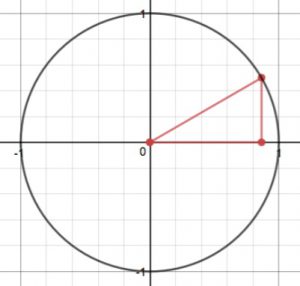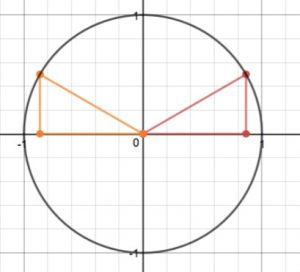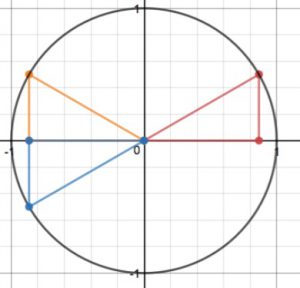Topics:
• Reflecting the special right triangles into the four quadrants to get other important points on the unit circle
• Angles (rotations) which terminate on an axis and the points on the unit circle
• Now that we have all of these important points, put them in the big unit circle picture I handed out. You can download another copy of it and use it for practice:
UnitCircleToFillIn
• Finding values of the trig function using the unit circle and reference angles.
We did this for two angles, one positive and one negative. (Sorry, I don’t recall which angles they were: if you know, please leave a comment!) The important thing is first to draw the angle, and then find its reference angle. We can then use either the unit circle or just the special right triangles to find the value of the trig function we want.
To draw angles which are given in radians without translating into degrees, I do as follows:
For example, if I want to draw the angle  , I first rewrite it as a mixed-number angle:
, I first rewrite it as a mixed-number angle:

So 
I remember that  wraps one time around the circle, so
wraps one time around the circle, so  will wrap twice around the circle, and then I go another
will wrap twice around the circle, and then I go another  which is one-third of a straight-line angle (since
which is one-third of a straight-line angle (since  is a straight-line angle). This ends up in the first quadrant and I can easily see that my reference angle is
is a straight-line angle). This ends up in the first quadrant and I can easily see that my reference angle is  by drawing it this way.
by drawing it this way.
It may seem really indirect to think this way, but the opposite is true: you are tying your mind to the appearance and actual size of the angles and associating them directly with the radian measures, so in even the short run it will benefit you greatly to do this rather than translating into degrees! Radians are actually much easier to work with than degrees once you get used to them.
• Finding angles if we know the value of the trig function – we will return to this next time!
Our example: what is the angle  between 0 and
between 0 and  if
if  ? We saw from the unit circle picture that there are two of them: one is
? We saw from the unit circle picture that there are two of them: one is  , and the other is $\latex \frac{5\pi}{6}$. We will return to this next time! Remember that in the unit circle picture, the cosine is the first coordinate and the sine is the second coordinate.
, and the other is $\latex \frac{5\pi}{6}$. We will return to this next time! Remember that in the unit circle picture, the cosine is the first coordinate and the sine is the second coordinate.
• Inverse trig functions and solving right triangles
The inverse trig functions are defined as follows:
The inverse sine function is  := the angle (rotation) between
:= the angle (rotation) between 
 and
and 
 inclusive, whose sine is x.
inclusive, whose sine is x.
The inverse cosine function is  := the angle (rotation) between
:= the angle (rotation) between 
 and
and 
 inclusive, whose cosine is x.
inclusive, whose cosine is x.
The inverse tangent function is  := the angle (rotation) between
:= the angle (rotation) between 
 and
and 
 , whose tangent is x.
, whose tangent is x.
These three functions are sometimes also called arcsine, arc-cosine, and arctangent. That means that we are looking for an arc on the unit circle, namely, a rotation. Radian measure is measuring this arc (thinking of it as a rotation on the unit circle) as we already saw looking at the discussion in Math is Fun. (here’s more)
In all three cases notice that the inverse functions give us the value of an angle (or rotation) if we already know the value of one of its trig functions. (However, it might not be the angle we want, because it picks out one of the infinite number of coterminal angles that all have that same value for the trig function. We will have to deal with this later.)
It is a good idea to read (and think of)  as “the angle whose sine is x” and so forth. This makes you concentrate on the fact that you are looking for an angle.
as “the angle whose sine is x” and so forth. This makes you concentrate on the fact that you are looking for an angle.
There is a very nice introduction to the inverse trig functions in Math is Fun, which I highly recommend that you read!
We did part of the WeBWorK in class. You will complete it for homework. For these problems, you are using your calculator to find values for the inverse trig functions, but think about what you are doing! Later on we will be finding the values without using a calculator, using our knowledge of the unit circle picture.
Homework:
• Review what we discussed in class, and read the Math is Fun links above about radians and about the inverse trig functions.
• Fill in your unit circle. Start practicing filling it in without looking at your notes: you will need to be able to come up with these numbers quickly. Here are two videos from Patrick’s Just Math Tutorials that give a nice trick to recall the important points on the unit circle:
A trick to remember values on the unit circle
How to remember all the important points in the unit circle
HOWEVER, I have a comment and a warning about these. First of all, this is not how I remember these values: I just use the two special triangles and reflect them the way we did in class, and also the four points on the unit circle where the axes intersect are easy to see. So it is possible to remember these values without “tricks”. Most importantly (this is the warning), make sure that you understand how we got these points in the first place, no matter how you end up remembering them! The reflections and the two special triangles ae important in their own ways, and you need to have a good understanding of what we are doing before you can build on it: just memorizing things without understanding will make your life very hard indeed.
• Do the WeBWorK: there are are now three assignments (two are from before) which are due Tuesday 11 PM, don’t wait!
• Do the following problems as well:
- Using the unit circle picture (or the special right triangles directly) but without using a calculator, find the exact values of the following: Remember first to draw the angle (without translating to degrees!)



- Using the unit circle picture (or the special right triangles directly) but without using a calculator, find the exact values of the following:
- The angles between 0 and
 whose cosine is
whose cosine is 
- The angles between 0 and
 whose sine is
whose sine is 
- The angles between 0 and
 whose sine is $0$
whose sine is $0$








